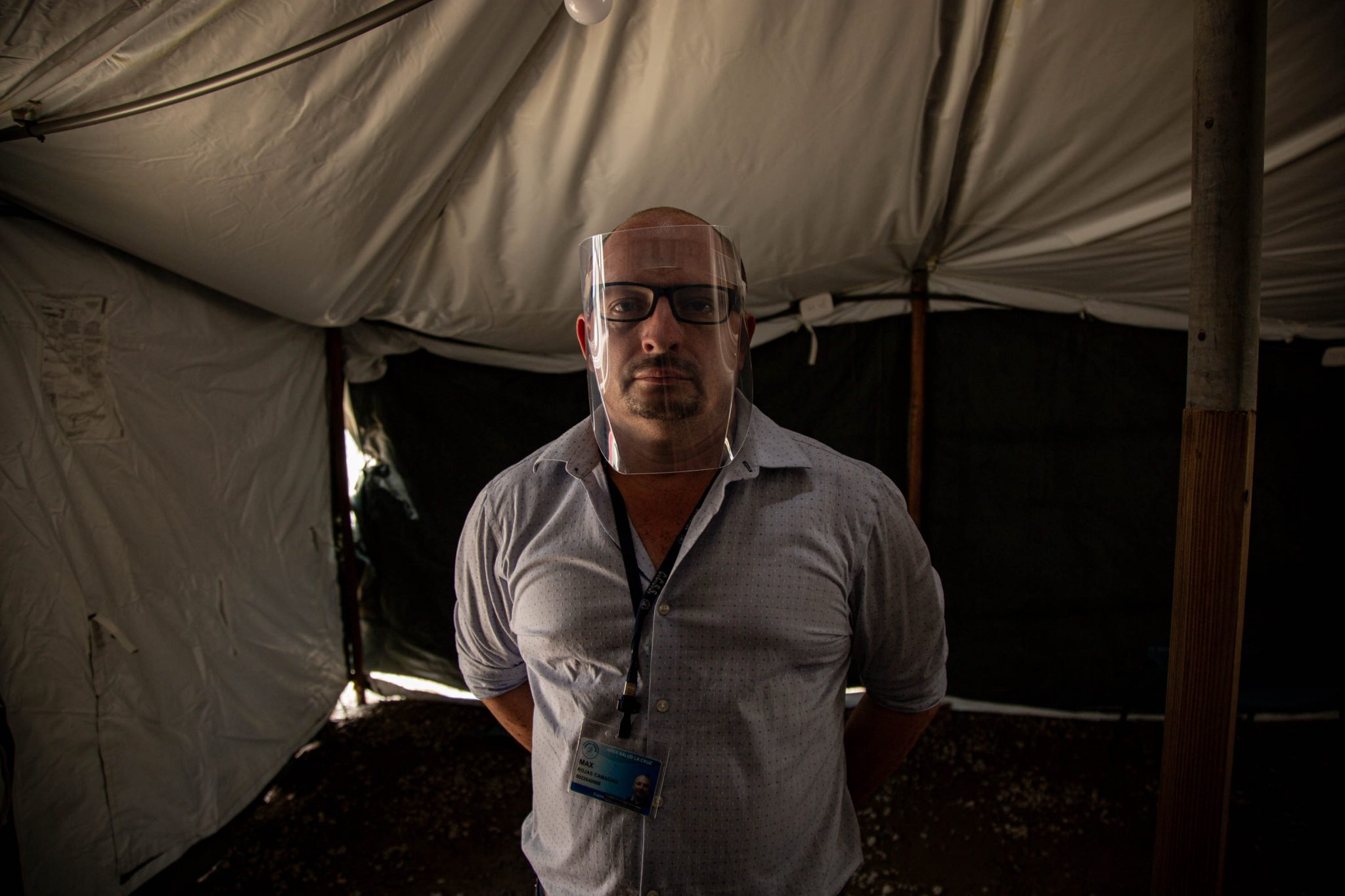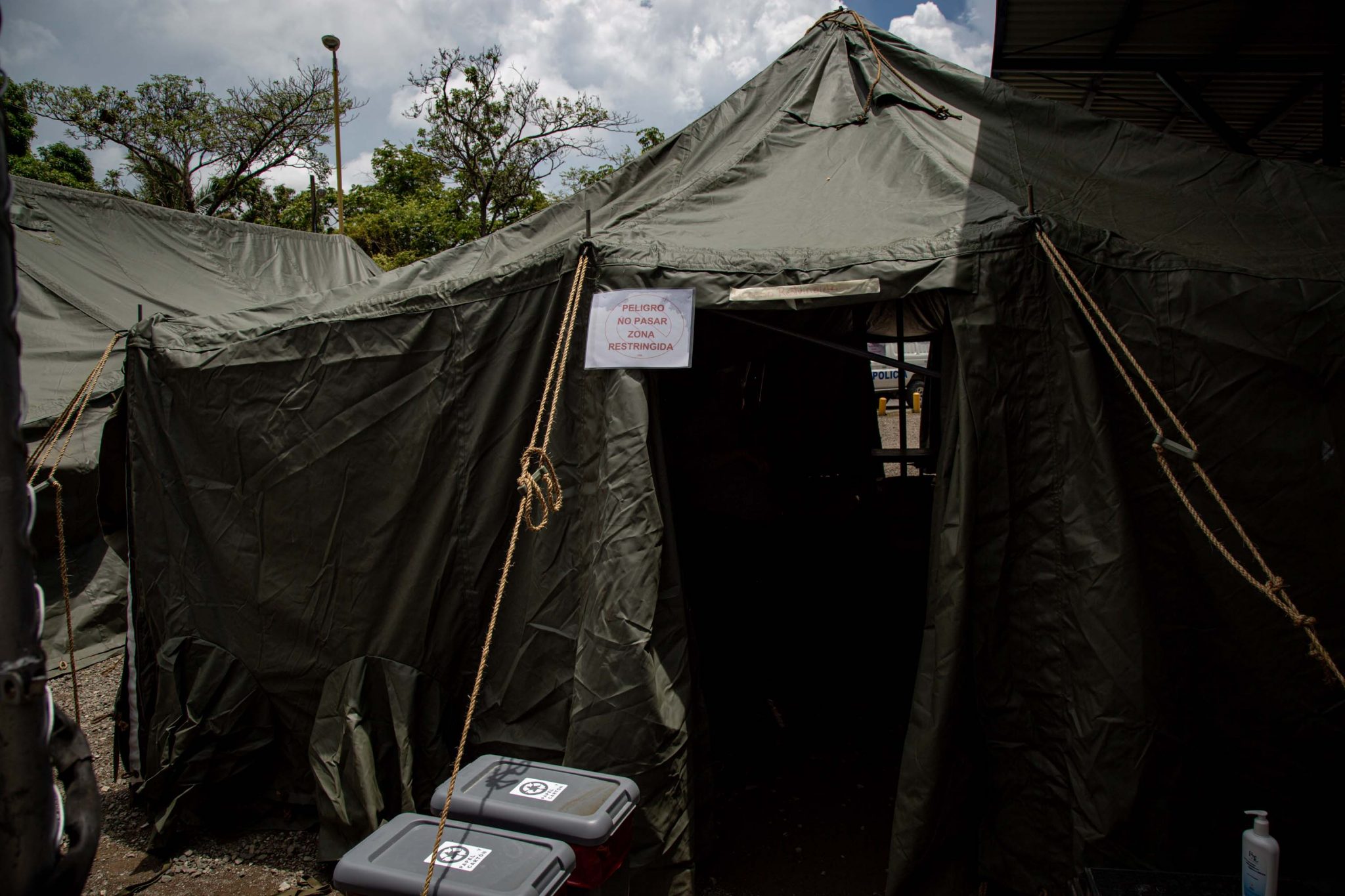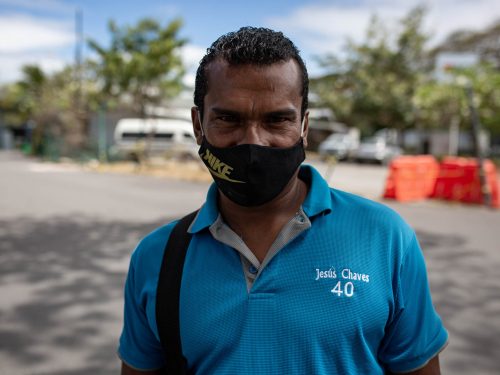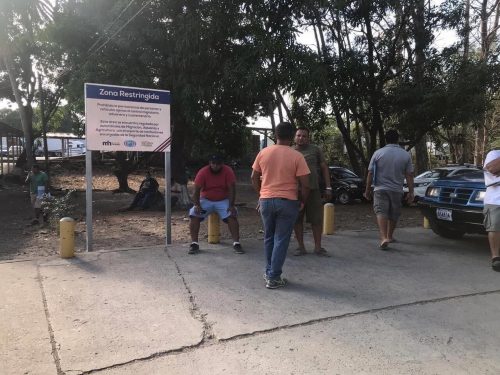
The temperature in Peñas Blancas rises to 35 degrees Celsius but, on occasions, it feels as if it were in 40. Health personnel cover themselves from head to toe with boots, gloves, cap, gown and glasses and enter moss green plastic tents. Within them the sultriness increases, but there is no alternative. They are tasked with testing carriers to detect COVID-19.
This is how Dr. Stephanie González, one of the doctors who faces the pandemic on the border of Peñas Blancas, relates it. The image was also immortalized in videos and photos on social networks and in the media.
In early May, the Ministry of Health notified officials at La Cruz clinic that they have to sample national and foreign truck drivers. Everyone wondered where they would do it. Dr. Max Rojas, in charge of the response to the pandemic in La Cruz, visited the border with several colleagues to find a space.
The one that best suited what we needed was a place that the customs people lent us,” says Rojas in his office at the clinic in La Cruz.
The site was not big enough for all the tasks they had to do: store the equipment, take the data from the carriers, test them, attend to decompensated people. So they borrowed two tents from the General-Directorate for Migration and Foreign Affairs. One was fitted with stretchers and the other with chairs to take the samples.
The heat from outside combines with the heat from inside the tents. Without any type of equipment on top beyond the face field and masks that we wear, this place feels like a sauna.
In the impromptu office located in customs, Dr. Stephanie González confirms us this: “When we were going to sample number forty, the body felt tired and dehydrated. Some of us were given heat strokes by the heap of sweating there taking samples.”
On May 5 they began to screen all domestic and foreign carriers. But since June 1 they have only tested nationals and residents, by an agreement between the government, the Council of Ministers of Central American Economic Integration (Comieco) and the Central American Federation of Transporters (Fecatrans).
The agreement also includes that foreigners have five days to stay in the country and that they can enter the fiscal warehouses or even the companies, if the products are unpackaged goods, refrigerated goods or dangerous materials.
Before allowing foreigners to enter, the staff do check their temperature, vital signs, interview them to find out where they come from and where they are going. Dr. Rojas assures that they reject those who present symptoms of respiratory infections. As of Wednesday, June 3, he says that they had rejected foreign carriers with symptoms, but he did not specify how many. On Monday 8th, we consulted to Ministry of Health the number of carriers rejected, but at the close of this note we did not receive it.
The task of health personnel was and continues to be risky. Carriers cross the countries of the region, from Guatemala to Panama, and each nation has different degrees of spread of the virus. Nicaragua and Panama, for example, are in the community contagion phase, that is, there are a large number of cases without an identified epidemiological link.
Dr. González assures that at the beginning the carriers did not understand why Costa Rica tested them if in other countries they only took their temperature.
We explain to them that the thermometer is not a classifier of whether or not you have coronavirus, because 10% [of the patients positive for COVID-19] do not have fever,” says González.
Since then and even today, the health team ensures that it educates carriers on handwashing and distancing protocols. “They put sinks, soap and towel dispensers and everything else. They are told ‘gentlemen, keep your distance, wash your hands, try not to be grouped together,’ ”explains Rojas.
In total, Costa Rica identified 61 carriers with coronavirus at the northern border during the three weeks that they tested nationals and foreigners. 45 of them were detected here in Peñas Blancas.
González says that “for good” none of the colleagues has been infected. A feat, taking into account that health personnel are one of the most vulnerable.
According to CCSS data, as of April 7, 146 officials had tested positive for COVID-19, that is, 11% of those confirmed as of that date. At this time, 73 officials are in isolation order because they have had contact of people with coronavirus.

Dr. Max Rojas appreciates that the Caja has given them the necessary supplies to operate, but acknowledges that they are not always enough. “Like everything, there are times when supplies run out.” There was a time when the staff ran out of N95 masks, he and part of the collaborators who work there say. At that point, they stopped the tasks and waited for them to arrive to continue screening.
Watch out on migration
The virus is now spreading more rapidly and growing in the northern zone and, therefore, in health personnel in those areas. At least four officials of Liberia Hospital have coronavirus and 14 were sent to isolation.
In San Carlos, also a border area, 41 officials received a health order for having had contact with COVID-19 positive patients. That canton is the one with the most active cases at the moment, 77 in total, according to the cut of this Monday, June 8.
The Health Minister said at the conference on Wednesday, May 27 that the situation in Nicaragua is currently the most risky for Costa Rica in terms of handling the new coronavirus.
Irregular migration in the northern zone is the greatest concern of the hierarchies who are dealing with the pandemic and of the officials who face it on the front line.
Health Minister Daniel Salas said so at the May 27 conference. And after that day, the government implemented a series of measures in the border cantons: the National Emergency Commission (CNE) declared the cantons of Pococí and Upala, the central district of Los Chiles, on orange alert; Venice and La Fortuna, in San Carlos; and also to the districts that present an increase in cases: Peñas Blancas in San Ramón; Cañas and Bebedero in Cañas; and Las Juntas in Abangares.
It also established a differentiated vehicle restriction in those places and in all the cantons bordering Nicaragua.
The Caja reinforced strategies to monitor the northern zone. “We are seeing that the cases are occurring in vulnerable populations, that have migratory roots, agricultural workers, in construction, they tend to be vulnerable populations that are below the poverty line,” explained the president of the CCSS, Román Macaya, at the conference on Sunday, June 7.
Now, health personnel will screen not only people with symptoms, but the general population of the districts most at risk. Also, they are contacting community leaders who already work hand in hand with the Ministry of Health and who can help identify people with symptoms, populations at risk (such as older adults with chronic diseases) and noncompliance with health orders.
Dr. Stephanie González and nurse Rossi Carvajal, from La Cruz medical team, assure that the border areas need more attention and resources.
They should give more money for infrastructure and medical personnel, in the event that migrants begin to pass,” says González. He pauses slightly and adds: “We are already seeing it, it is already being lived.”
Added to this is the fact that the Caja has not brought the equipment to process the samples and detect the coronavirus to Guanacaste, a need that Dr. Rojas saw as a priority when testing nationals and foreigners.
“They gave us an explanation that the capacity of the equipment that Liberia will have is to process four samples per hour. So, crunching numbers, in the end there was no way to evolve more.”
The staff of La Cruz, and of the other Guanacaste medical centers, continue to send the tests to San José, despite the fact that since March 25 the Health Minister Daniel Salas emphasized the need to decentralize the tests. He even said that this was urgent, especially in places where “the phenomenon [of contagion] is eventually occurring.”
The CCSS reaffirmed that same commitment on April 13. Active cases continued to rise in the province until reaching the highest peak of the entire pandemic, but the tests continue without reaching the province due to “provider logistics issues,” said Dr. Mario Ruiz, manager of the CCSS, in the conference on May 14.
The institution has regionalized equipment and kits in the health areas of Los Santos, Puriscal, Acosta, Paquera, Siquirres, Corralillo, Upala, Chomes-Monteverde and Guatuso. According to the Caja, they are planning to send equipment to border areas.
And it is an urgent need, according to health personnel who work in Peñas Blancas. “La Cruz is a time bomb, and it can be a time bomb for all of Costa Rica,” says Dr. González.








Comments